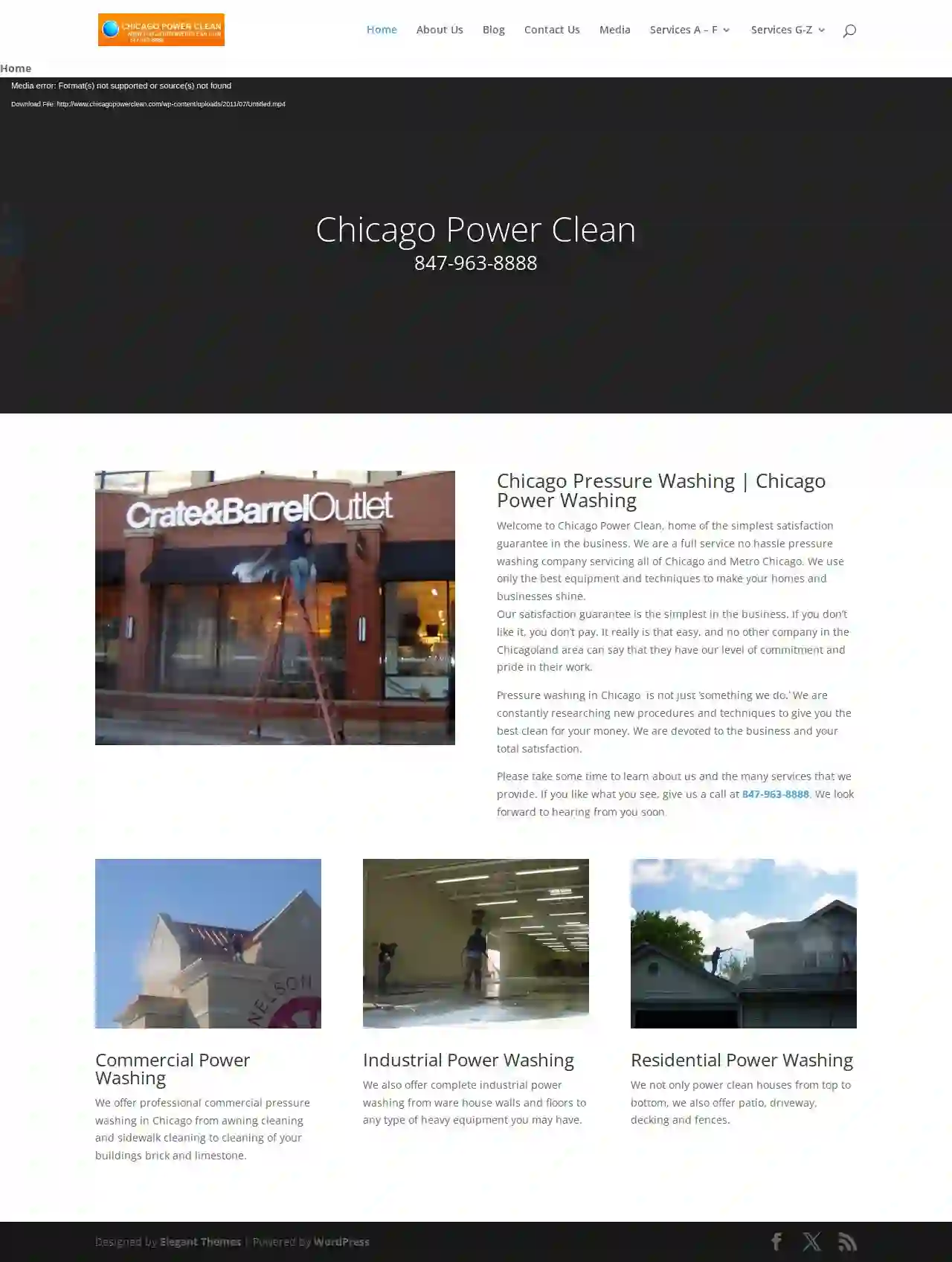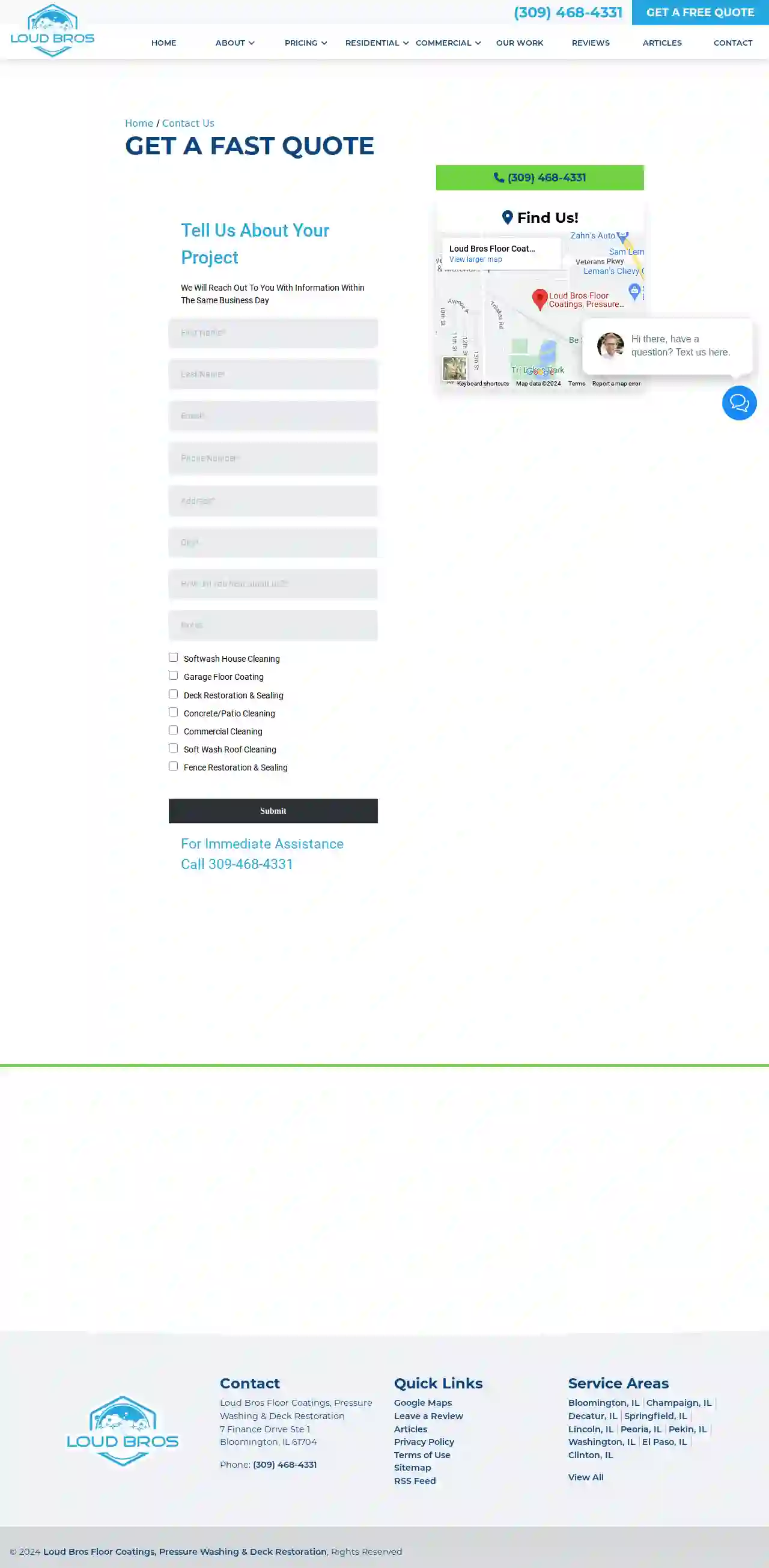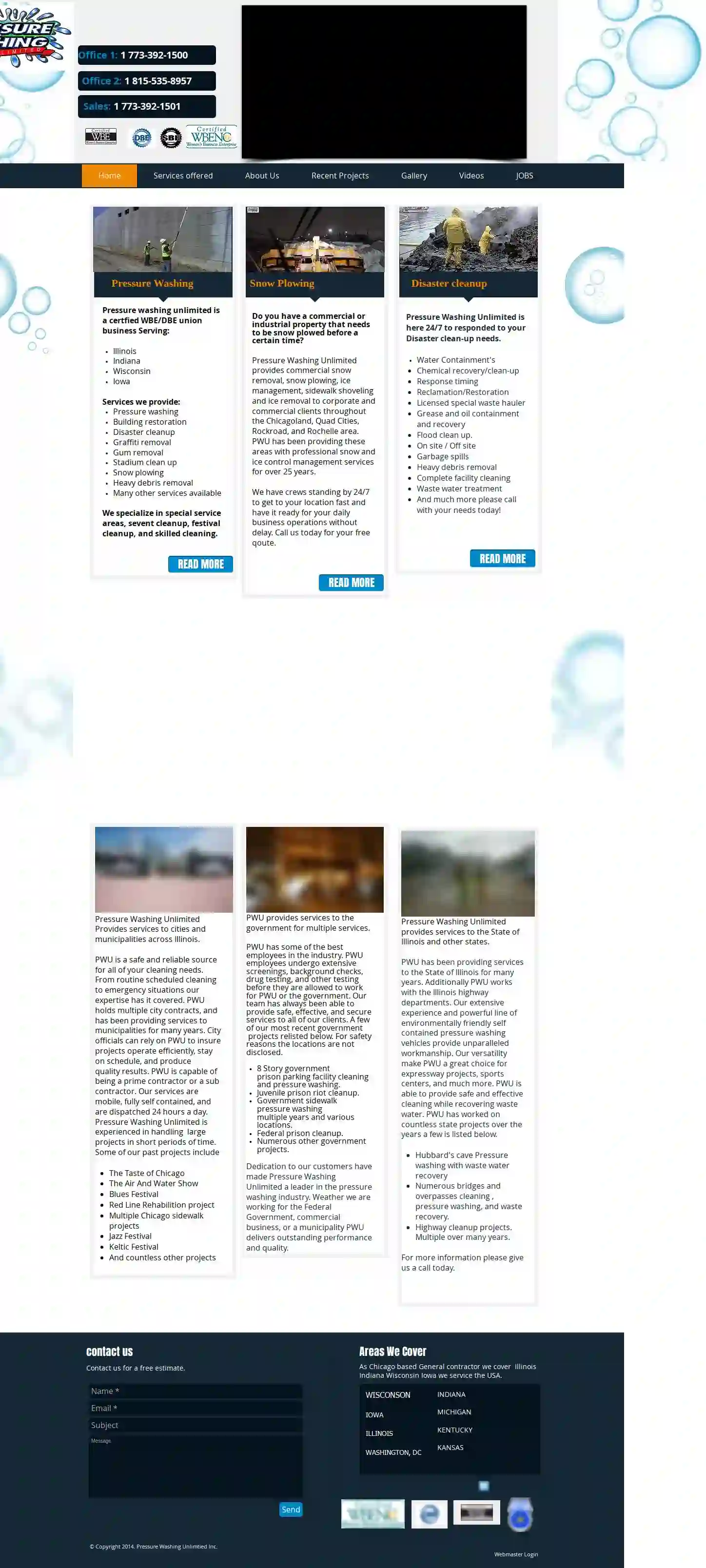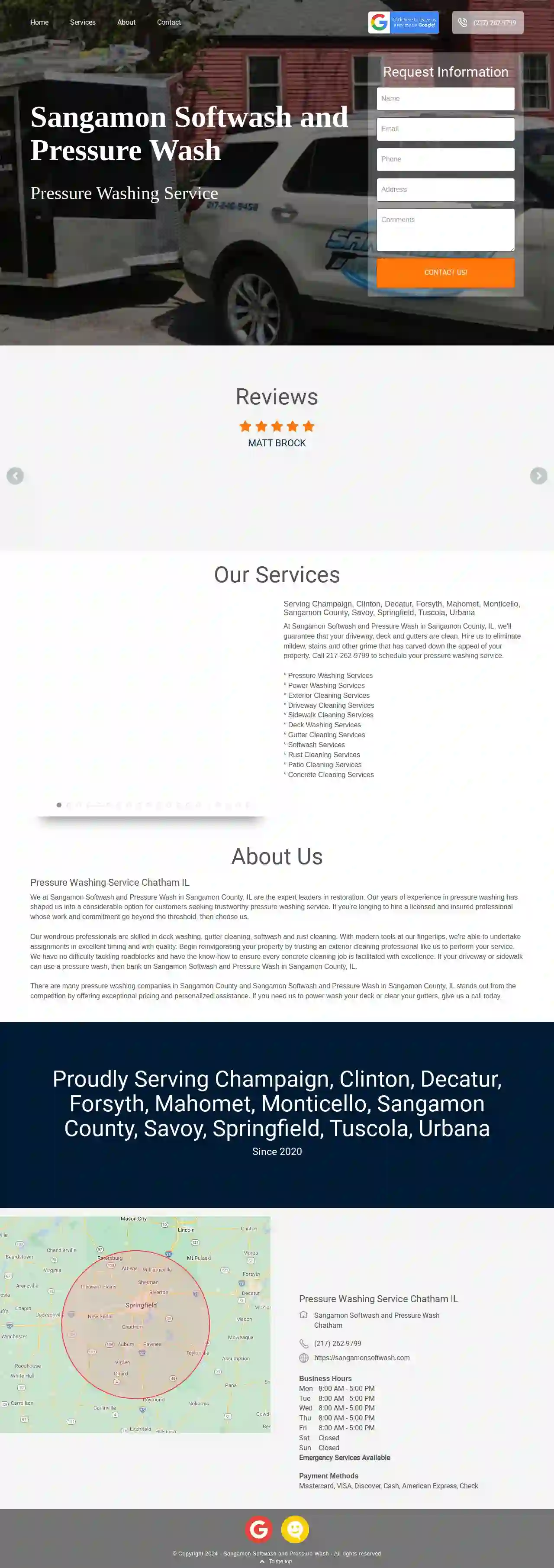Pressure Washing Westmont
Best Pressure Washing in Westmont
Receive multiple Power Washing quotes for your project today! Compare profiles, reviews, accreditations, portfolio, etc... and choose the best service.

Chicago Power Clean
51 reviews123 Main Street, Suite 100, Chicago, 60601, USWelcome to Chicago Power Clean, home of the simplest satisfaction guarantee in the business. We are a full service no hassle pressure washing company servicing all of Chicago and Metro Chicago. We use only the best equipment and techniques to make your homes and businesses shine. Our satisfaction guarantee is the simplest in the business. If you don’t like it, you don’t pay. It really is that easy, and no other company in the Chicagoland area can say that they have our level of commitment and pride in their work. Pressure washing in Chicago is not just ‘something we do,’ We are constantly researching new procedures and techniques to give you the best clean for your money. We are devoted to the business and your total satisfaction. Please take some time to learn about us and the many services that we provide. If you like what you see, give us a call at 847-963-8888. We look forward to hearing from you soon. Commercial Power Washing We offer professional commercial pressure washing in Chicago from awning cleaning and sidewalk cleaning to cleaning of your buildings brick and limestone. Industrial Power Washing We also offer complete industrial power washing from ware house walls and floors to any type of heavy equipment you may have. Residential Power Washing We not only power clean houses from top to bottom, we also offer patio, driveway, decking and fences.
- Services
- Why Us?
- Accreditations
- Our Team
- Testimonials
- Gallery
Get Quote
Pressure Washing Company
7 Finance Drive Ste 1, Bloomington, 61704, USLoud Bros Pressure Washing is a professional power washing and garage floor coating company based in Central Illinois. They specialize in providing top-notch exterior cleaning services for home and business properties, using eco-friendly chemicals to protect and enhance the longevity of paint. Their services include house washing, roof cleaning, garage floor coatings, storefront washing, and more. With a focus on quality and customer satisfaction, Loud Bros Pressure Washing is the go-to choice for those seeking to restore the beauty of their property.
- Services
- Why Us?
- Accreditations
- Our Team
- Testimonials
- Gallery
Get Quote
Pressure Washing Unlimited/ PWU
52 reviewsSuite 100, Chicago, IL, 123 Main St, 60601, USPressure Washing Unlimited is a certified WBE/DBE union business that specializes in providing a variety of services including pressure washing, building restoration, disaster cleanup, graffiti removal, gum removal, stadium cleanup, snow plowing, and heavy debris removal. They serve Illinois, Indiana, Wisconsin, and Iowa.
- Services
- Why Us?
- Accreditations
- Our Team
- Testimonials
- Gallery
Get Quote
Airstream Pressure Washing, Inc
4.25 reviews1625 Gilpen Ave, South Elgin, 60177, USAirstream Pressure Washing is a locally owned and operated business dedicated to providing high-quality pressure washing services to residential, commercial, and fleet clients in South Elgin, Illinois, and the surrounding areas. We understand the importance of a clean and well-maintained exterior for both homes and businesses, and we strive to exceed our clients' expectations with our professional and reliable service. Our team of skilled technicians utilizes state-of-the-art equipment and eco-friendly cleaning solutions to effectively remove dirt, grime, mildew, and mold from a variety of surfaces, including siding, decks, patios, fences, and more. We are fully insured and committed to providing safe and efficient service. At Airstream Pressure Washing, we take pride in our attention to detail and commitment to customer satisfaction. The owners are actively involved in the day-to-day operations and prioritize building lasting relationships with our clients. We believe in transparency and clear communication, ensuring that our clients are informed every step of the way. Whether you need a one-time cleaning or a recurring maintenance schedule, we are here to help you keep your property looking its best. Contact us today for a free estimate and experience the Airstream Pressure Washing difference!
- Services
- Why Us?
- Gallery
Get Quote
AMG Pressure Washing
Bloomington, 61701, USAMG Pressure Washing is a residential and commercial pressure washing and soft-washing contractor servicing Bloomington and the surrounding areas. We are proud to bring our industry experience to each and every job we do. Whether you're looking to clean up your driveway to restore curb appeal, or prepping for a major project, our knowledgeable team has the skills and tools to make sure the job is done right. Our team is large enough to deliver professional exterior cleaning solutions while offering the personal touches that ensure we meet your goals and exceed your expectations. Contact us today for additional information or to schedule a free estimate.
- Services
- Why Us?
- Gallery
Get Quote
Sangamon Softwash and Pressure Wash
54 reviews123 Main St, Chatham, IL, 62521, USSangamon Softwash and Pressure Wash is a professional exterior cleaning service based in Sangamon County, IL. They specialize in pressure washing, power washing, and softwash services for various surfaces including driveways, sidewalks, decks, and gutters. Their team of skilled professionals uses modern tools to ensure quality work and timely completion of projects. They offer competitive pricing and personalized assistance to customers, serving areas such as Champaign, Clinton, Decatur, Forsyth, Mahomet, Monticello, Sangamon County, Savoy, Springfield, Tuscola, and Urbana.
- Services
- Why Us?
- Accreditations
- Our Team
- Testimonials
- Gallery
Get Quote
Chicago Racoons - Window & Power Washing
4.936 reviews443 W Irving Park Rd, Chicago, IL, 60618, USChicago Racoons is a premier outdoor cleaning company specializing in pressure washing services in Chicago, IL, and the surrounding suburbs. With years of industry experience, they have a solid understanding of how to make exterior surfaces shine. Their dedication to improvement and exceptional service is what truly distinguishes them from the competition.
- Services
- Why Us?
- Accreditations
- Our Team
- Testimonials
- Gallery
Get Quote
Custom Powerwash Service
5116 reviewsHerrin, IL, 1311 N 9th St, 62948, USCustom Powerwash Service is Herrin's top-rated partner in transforming properties with pristine cleanliness through power washing! As a distinguished power washing company, we have earned our reputation through a steadfast commitment to unparalleled quality and unwavering customer trust. Our mission is to ensure your property leaves an indelible mark of cleanliness and beauty. With a track record of excellence and a team of seasoned professionals, we stand as a beacon of reliability in the power washing industry. Whether it's soft wash house washing, roof cleaning, or concrete cleaning, our services are meticulously designed to exceed expectations and redefine the standards of cleanliness.
- Services
- Why Us?
- Accreditations
- Our Team
- Testimonials
- Gallery
Get Quote
Quality Blast
56 reviewsDewitt, IL, 12247 Solomon Rd, 61735, USQuality Blast is Bloomington's go-to professional pressure washer! We offer premium pressure washing and soft washing services for homeowners and businesses. Our team has extensive experience and knowledge, plus the best equipment for the job. We work closely with property owners to discuss and create a personalized cleaning plan that will fit the needs of their property.
- Services
- Why Us?
- Accreditations
- Our Team
- Testimonials
- Gallery
Get Quote
217 Soft Wash
514 reviews515 S Walnut St, Arthur, 61911, USMake Your Home or Business Shine Like New! Call 217 Soft Wash Today! Get Free Quote Just a Call Away Premier Pressure Washing Company In Mattoon and Surrounding Areas! If you're a homeowner or commercial property owner in the greater Mattoon region and you're on the hunt for a dedicated pressure washing company, then you'll want to reach out to our experts at 217 Soft Wash today. Ever since we launched our business several years ago, we've made it our mission to deliver unparalleled pressure washing for all our clients, residential and commercial, in Mattoon and surrounding areas. No matter what you need assistance with, from sidewalk cleaning to full exterior house washing, you can count on us. Read on to learn more about how we can help you out. If you have any additional questions, feel free to reach out to us. We're standing by to take your call and to assist with whatever concerns you may have.
- Services
- Why Us?
- Accreditations
- Our Team
- Testimonials
- Gallery
Get Quote
Over 60,241+ Janitorial Companies in our network
Our cleaning services operate in Westmont and beyond!
CleaningMatch has curated and vetted Top Cleaning Companies near Westmont. Find a reliable pro today.
Frequently Asked Questions About Pressure Washing
- Pressure Washing: If your siding is in good condition but dirty or stained, pressure washing can effectively restore its appearance without the need for painting.
- Painting: If your siding is faded, chipped, peeling, or damaged, pressure washing alone may not be sufficient. Painting provides a fresh coat of protection and a new look.
- Pressure Washing Before Painting: Pressure washing is an essential step before painting, as it removes dirt, grime, and loose paint, creating a clean surface for the new paint to adhere to.
- Wood Siding: High-pressure washing can damage wood fibers, leading to splintering or etching. Soft washing is the recommended method for cleaning wood siding.
- Asphalt Shingles: High-pressure water can dislodge granules from asphalt shingles, reducing their lifespan. Soft washing is a gentler alternative for roof cleaning.
- Painted Surfaces: High pressure can strip paint from surfaces. Always test pressure washing on an inconspicuous area before cleaning painted surfaces.
- Windows and Screens: The force of pressure washing can break windows or damage delicate window screens. Traditional cleaning methods are better suited for windows and screens.
- Spring and Fall: Spring and fall are often ideal for pressure washing as the temperatures are moderate and the weather is typically dry.
- Summer: Pressure washing can be done in the summer, but avoid doing so during the hottest part of the day to prevent the cleaning solutions from drying too quickly and leaving streaks.
- Winter: Pressure washing is possible in the winter, but be mindful of freezing temperatures that can affect cleaning solutions and cause slippery surfaces.
- Pressure Washing: For hard surfaces like concrete, brick, or decks, pressure washing can effectively remove mold and mildew. Use a cleaning solution containing bleach or mildewcide for optimal results.
- Soft Washing: For delicate surfaces like roofs or siding, soft washing is the preferred method for mold and mildew removal. Soft washing uses low-pressure water and specialized cleaning solutions to gently remove mold and mildew without damaging the surface.
- Prevention: After cleaning, take steps to prevent future mold and mildew growth by addressing moisture issues, such as fixing leaks, improving ventilation, and trimming vegetation that creates shade and traps moisture.
Is it better to pressure wash or paint my house?
Assess the condition of your siding and your desired outcome to determine whether pressure washing, painting, or a combination of both is the best approach.
Is pressure washing safe for all surfaces?
Always consult with a professional pressure washing company to determine the appropriate cleaning method for your specific surfaces.
What is the best time of year for pressure washing?
Choose a day with mild temperatures and dry weather for optimal pressure washing results. Avoid pressure washing in extreme heat, freezing temperatures, or rainy conditions.
Can pressure washing remove mold and mildew?
If you have extensive or persistent mold and mildew problems, consult with a professional pressure washing company or a mold remediation specialist.
Is it better to pressure wash or paint my house?
- Pressure Washing: If your siding is in good condition but dirty or stained, pressure washing can effectively restore its appearance without the need for painting.
- Painting: If your siding is faded, chipped, peeling, or damaged, pressure washing alone may not be sufficient. Painting provides a fresh coat of protection and a new look.
- Pressure Washing Before Painting: Pressure washing is an essential step before painting, as it removes dirt, grime, and loose paint, creating a clean surface for the new paint to adhere to.
Assess the condition of your siding and your desired outcome to determine whether pressure washing, painting, or a combination of both is the best approach.
Is pressure washing safe for all surfaces?
- Wood Siding: High-pressure washing can damage wood fibers, leading to splintering or etching. Soft washing is the recommended method for cleaning wood siding.
- Asphalt Shingles: High-pressure water can dislodge granules from asphalt shingles, reducing their lifespan. Soft washing is a gentler alternative for roof cleaning.
- Painted Surfaces: High pressure can strip paint from surfaces. Always test pressure washing on an inconspicuous area before cleaning painted surfaces.
- Windows and Screens: The force of pressure washing can break windows or damage delicate window screens. Traditional cleaning methods are better suited for windows and screens.
Always consult with a professional pressure washing company to determine the appropriate cleaning method for your specific surfaces.
What is the best time of year for pressure washing?
- Spring and Fall: Spring and fall are often ideal for pressure washing as the temperatures are moderate and the weather is typically dry.
- Summer: Pressure washing can be done in the summer, but avoid doing so during the hottest part of the day to prevent the cleaning solutions from drying too quickly and leaving streaks.
- Winter: Pressure washing is possible in the winter, but be mindful of freezing temperatures that can affect cleaning solutions and cause slippery surfaces.
Choose a day with mild temperatures and dry weather for optimal pressure washing results. Avoid pressure washing in extreme heat, freezing temperatures, or rainy conditions.
Can pressure washing remove mold and mildew?
- Pressure Washing: For hard surfaces like concrete, brick, or decks, pressure washing can effectively remove mold and mildew. Use a cleaning solution containing bleach or mildewcide for optimal results.
- Soft Washing: For delicate surfaces like roofs or siding, soft washing is the preferred method for mold and mildew removal. Soft washing uses low-pressure water and specialized cleaning solutions to gently remove mold and mildew without damaging the surface.
- Prevention: After cleaning, take steps to prevent future mold and mildew growth by addressing moisture issues, such as fixing leaks, improving ventilation, and trimming vegetation that creates shade and traps moisture.
If you have extensive or persistent mold and mildew problems, consult with a professional pressure washing company or a mold remediation specialist.